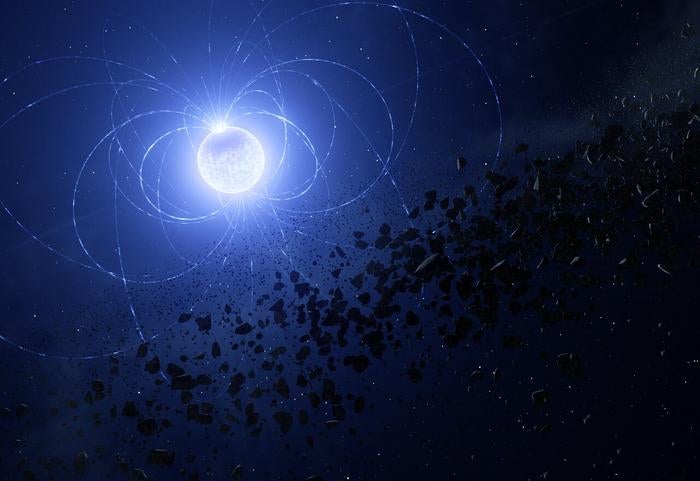Scientists find star with ‘scar’ from destroying planets
White dwarfs – like our Sun at the end of its life – can cannibalise parts of their own planetary systems

Scientists have found a star with a marked “scar” from destroying the planets that surround it.
When stars like our own Sun reach the end of their life, they can become a white dwarf, consuming the planets and asteroids that surround them. Now scientists have found for the first time that the process can leave a lasting mark on the star itself, a unique “scar”.
It is as if the Sun had reached the end of its life and devoured our solar system, leaving a mark of the planets – including our own – that surround us today.
“It is well known that some white dwarfs — slowly cooling embers of stars like our Sun — are cannibalising pieces of their planetary systems. Now we have discovered that the star’s magnetic field plays a key role in this process, resulting in a scar on the white dwarf’s surface,” said Stefano Bagnulo, an astronomer at Armagh Observatory and Planetarium in Northern Ireland, UK, and lead author of the new study.
The star consists of a concentration of metals that are imprinted on the surface of the star. That star is known as WD 0816-310 – and while it was once similar to but larger than our Sun, today it is roughly the size of the Earth.
Those metals were once the beginnings of planets. They never reached the size our own Earth, researchers said.
“We have demonstrated that these metals originate from a planetary fragment as large as or possibly larger than Vesta, which is about 500 kilometres across and the second-largest asteroid in the Solar System,” says Jay Farihi, a professor at University College London, UK, and co-author on the study.
The metals appear to be located in one specific part of the star’s surface, rather than being spread across it. And the patch appears to be on one of the planet’s magnetic poles – suggesting that the magnetic field pulled the material onto the star and left the scar behind.
“Surprisingly, the material was not evenly mixed over the surface of the star, as predicted by theory. Instead, this scar is a concentrated patch of planetary material, held in place by the same magnetic field that has guided the infalling fragments,” says co-author John Landstreet, a professor at Western University, Canada, who is also affiliated with the Armagh Observatory and Planetarium.
“Nothing like this has been seen before.”
The findings are described in a paper, ‘Discovery of magnetically guided metal accretion onto a polluted white dwarf’, appearing in The Astrophysical Journal Letters.
Join our commenting forum
Join thought-provoking conversations, follow other Independent readers and see their replies
Comments
Bookmark popover
Removed from bookmarks